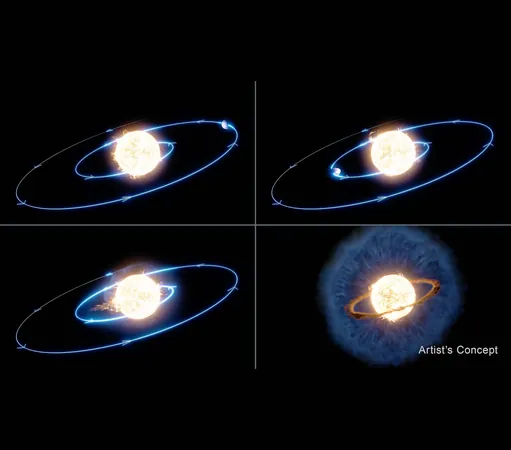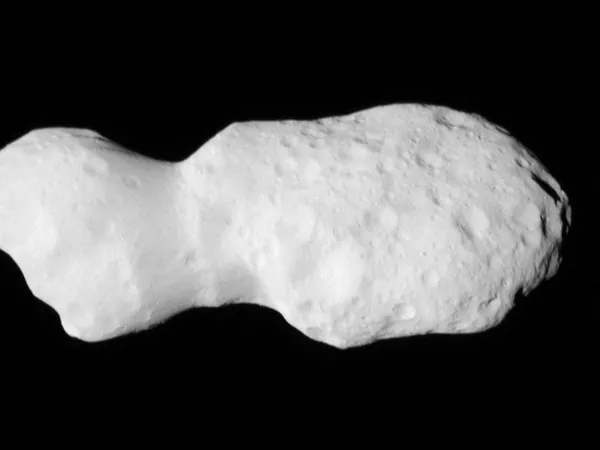
Astonishing Discovery: Webb Captures the First Planetary Devouring Event!
2025-04-12
Author: Wai
The Shocking Truth Behind Planetary Devouring
Scientists have long envisioned an aging star swallowing a planet in a blaze of glory, yet new evidence reveals a much calmer and more gradual process. Data from NASA’s James Webb Space Telescope (JWST) unveils a compelling narrative: instead of a cataclysmic engulfment, the planet spiraled inwards over time, leading to its eventual fiery demise.
Breaking Ground with the James Webb Space Telescope
This groundbreaking research, conducted by NSF’s NOIRLab scientists, utilized the JWST's mid- and near-infrared tools to gain unprecedented insights into the fate of planetary systems like ours. This new understanding dismantles previous theories and paves the way for future astronomical explorations.
The Planet that Disappeared
Located around 12,000 light-years away in the Milky Way, the event first caught astronomers' attention in 2020 when a flash of visible light, designated ZTF SLRN-2020, was detected. Initial infrared signals hinted at dust accumulation, prompting further scrutiny which ultimately suggested the star was transitioning into a red giant.
However, more detailed observations with Webb showed that this star didn’t swell as expected. Instead, it maintained its size and never had the capability to swallow its neighboring planet whole.
A Gradual and Violent Encounter
Astronomers now theorize that the planet, roughly the size of Jupiter and orbiting much closer to its star than Mercury is to the Sun, spiraled inward over millions of years. As it neared the star’s atmosphere, this prompted a runaway reaction; the closer it got, the faster it spiraled down.
Morgan MacLeod noted, "The planet started to smear around the star as it fell in, creating a violent interaction that blew gas outward from the star's surface." This generated a dust halo that glowed in infrared long after the planet's demise.
Aftermath: New Discoveries Await
Utilizing Webb’s Near-Infrared Spectrograph (NIRSpec), researchers uncovered not only the expected cool dust cloud but also a surprising hot gas disk rich in carbon monoxide – a signature of planet-forming regions. Colette Salyk remarked, "Seeing features indicative of a region where planets form, despite the absence of new birth, was unexpected and enlightening."
Why This Matters for Our Own Planetary Future
This colossal event, monitored under Webb's Guaranteed Time Observation program, stands as the only observed instance of its kind, offering unprecedented insights into stellar evolution. With an eye towards future detections, scientists remain eager to unravel similar phenomena.
What About Earth? Will We Meet a Similar Fate?
As our Sun ages in the next five to seven billion years, it will reach a critical point, expanding into a red giant possibly consuming Mercury and Venus in the process. While some theorize that Earth may escape engulfment, the harsh heat would render the planet uninhabitable, boiling oceans and vaporizing the atmosphere.
The Future of Stellar Observations
Expect more revelations like ZTF SLRN-2020 with upcoming observatories such as the Vera C. Rubin Observatory and NASA’s Nancy Grace Roman Space Telescope gearing up to scan the cosmos. These powerful tools promise to deepen our understanding of the dramatic interactions between stars and planets.
The study detailing these findings has been published in the Astrophysical Journal, marking a significant milestone in our quest to understand the cosmos.




 Brasil (PT)
Brasil (PT)
 Canada (EN)
Canada (EN)
 Chile (ES)
Chile (ES)
 Česko (CS)
Česko (CS)
 대한민국 (KO)
대한민국 (KO)
 España (ES)
España (ES)
 France (FR)
France (FR)
 Hong Kong (EN)
Hong Kong (EN)
 Italia (IT)
Italia (IT)
 日本 (JA)
日本 (JA)
 Magyarország (HU)
Magyarország (HU)
 Norge (NO)
Norge (NO)
 Polska (PL)
Polska (PL)
 Schweiz (DE)
Schweiz (DE)
 Singapore (EN)
Singapore (EN)
 Sverige (SV)
Sverige (SV)
 Suomi (FI)
Suomi (FI)
 Türkiye (TR)
Türkiye (TR)
 الإمارات العربية المتحدة (AR)
الإمارات العربية المتحدة (AR)